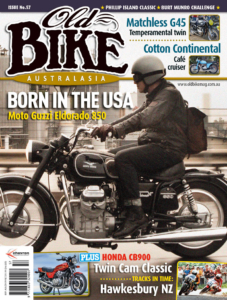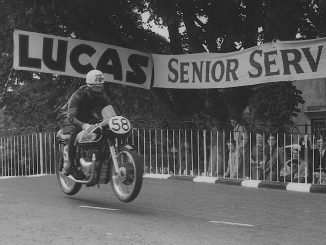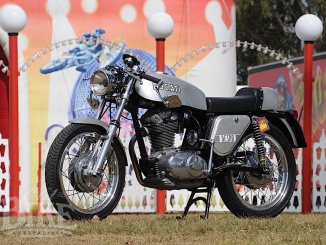
Story: Jim Scaysbrook • Photos: Keith Ward, Charles Rice, Ron Robinson, FoTTofinders.
At the end of 1962, Ron Robinson was at the crossroads. He’d been racing in Australia since 1955, and had honed his skills to the point that he had been offered support to race at the Isle of Man in 1963 – the fulfilment of a lifelong dream.
Nearing 30 years of age, he figured it was now or never. He’d had a successful season, winning the 350cc event at Hume Weir and the same class at the fast and dangerous public road circuit at Longford, Tasmania. But late in that same year, he had undertaken a tour of New Zealand for a race series – four events in each island – and he had been made a tempting offer by none other than Burt “World’s Fastest Indian” Munro.
“I went over by boat and my bike went as my work tools”, recalls Ron. “The last race of the series was at Teretonga, at Invercargill at the bottom of the south island. I won a race there and I met Burt Munro and he invited me to try out his Indian at Oreti Beach. It was the test machine with no streamlining. There was a black line down the centre of the sand and they said, ‘Just follow that. Don’t watch where you’re going, just watch the black line’, so that’s what I did. It only had three gears, and no brakes, and they had to push me until I was doing about 120 km/h until I could pull away from the pushing vehicle. So then Burt put the engine in the other chassis with streamlining and we took it out on the Monday and with stopwatch timing they reckon I got it up to just over 300 km/h in the end. I only weighed 62 kg. Burt was pretty impressed with that and he said to me, ‘Come to America with me and you can ride it, we’ll set a world record’. I thought pretty seriously about this but neither of us had much money. I would have had to put money in it, and also walk away from my plan to race at the TT, so in the end I decided on Europe.”

He took with him a 500 Manx Norton that he had purchased in Melbourne. It was an ex-works 1954 short stroke model that had been raced by top rider Alan Trow. It was almost complete – one vital missing component being the cam box. Ron contacted the Norton factory and was told they would build up a cam box and bring it to the Isle of Man in time for practicing. It was intended to be a short exercise – maybe a couple of years simply to satisfy the urge to experience the ‘ big time’. However, it would be 42 years before Ron returned to his native Melbourne, and only then because his mother had passed away and he needed to settle her affairs. That trip back to Melbourne would change his life, and not for the better.

It was the 1955 Victorian TT at the public roads circuit at Little River, between Melbourne and Geelong, where Ron had made his racing debut, aboard a well-worn bronze head KTT Velocette. That machine gave way to an equally well-used 7R AJS, on which Ron contested his first Bathurst meeting in 1958. The 7R, an early 1950s long stroke model, was well outclassed and Ron decided he needed some more competitive equipment. Driving to Queensland, he purchased the 500cc G45 Matchless that had been imported by Markwell Brothers in 1955 and raced by Royce Nixon. While up north, Ron contested the Queensland TT at Lowood, a former airfield circuit near Ipswich and twice finished second to Kel Carruthers on his Vincent Comet-engined Norton. As Ron discovered, while it was fast, the G45 had a deserved reputation for unreliability. “The main problem was the exhaust cam profile, which was too radical. It had triple valve springs which put too much pressure on the seat, and it used to snap the mounting pillar in the head. I welded up these pillars, changed to double valve springs and re-profiled the cam, and I had no more trouble. I could go to 9,000 rpm with no trouble.” He also dug deep into his savings and arranged for Olympic club mate Ron Miles to buy a brand new 350cc Manx Norton in England and bring it home for him in 1960. “I worked for Eddie Thomas, who had a speed tuning shop in Caulfield and we had our own cam grinder. I put a 500 Manx carb on the 350 Manx and made my own cams with extreme overlap, which was necessary to run the big carb. It was very quick in the high range.”


Although he was listed as A-Grade in Victoria, the Bathurst organisers accepted his entry for the Junior Non Expert Division 2 at Easter 1961, and he simply disappeared, putting nearly half a minute between himself and second place at the chequered flag. “That Norton was a fabulous bike, I should have kept it and taken it to Europe with me. But I had a new one on order so I let it go to Ron Angel. When I got there the factory said they couldn’t deliver, so I was in a panic. Then I met Mike Hailwood at Doll’s guest house in Shepherd’s Bush (London) and he told me where his last 350 Norton was – it was a Bill Lacey tuned bike – so I went up to Durham (north east coast) and bought it. Mike took me out to Brands Hatch and showed me the way around. In the race it rained and six of us fell off.”

At the Isle of Man TT he took things conservatively, finishing 34th in the Junior and 33rd in the Senior. As it turned out, the promised cam box for the 500 arrived scarcely in time for the final practice session on the Friday. “I had qualified for the 350 and 500 races on the 350 Manx and it was very quick, a good running motor. I just changed the numbers and went out in the 500 sessions. Then on the last practice on the Friday afternoon I finally rode the 500, boy that thing was quick.”
His first race in Europe was the 1963 Belgian Grand Prix, but he looked like failing to qualify, and says that Jack Ahearn put him in his van and drove around the circuit many times to show him the line. “If Jack hadn’t shown me the way, I would never have got the hang of that track. I finished 32nd, and 8th the next year. His first win came in September at Laxenburg, near Vienna. Despite crashing in the earlier 350 race, he came through the field to win the Senior by 9 seconds from local riders Eddie Lenz and Rudi Thalhammer.

Another win came at Zolder, Belgium in the 350cc class, with second in the 500 on the G45 Matchless he had also purchased in England. The results led to an offer from the Budapest club to compete in their races around a street circuit, which came with certain conditions. “They wanted the local champ, Georges Kurucz, to win the 500 race, and we would share the money equally. I won the 350 and could have done the same in the 500, but I hung back to let him win. I had an ex-works G45 Matchless then, and I was going to make sure he worked hard for the win, but I locked the front wheel and dropped it and broke my collarbone. This was a real handling problem with the G45 and I was going to change the steering head angle to stop it doing this. The Budapest club wanted my G45, but under the Communists this was tricky, so we did a deal. They had a 7R and so they altered the numbers because I needed to get out over the border with the same stuff that I’d brought into Hungary, so the club put the G45 engine and frame numbers on the 7R and painted the tank like the Matchless and I took that out instead. When I got back to Vienna I received a letter from the doctor who looked after my shoulder which said ‘Please don’t come back to Budapest because they will put you in gaol’. Somebody squeaked. I went back after the communists were gone and nobody said anything!”

Ron’s wife, Magda, whom he met in Melbourne, was Austrian, so he based himself in her home town of Vienna where he attracted the attention of Hans Hess, who had a successful carpet business and who agreed to sponsor him. “Hans went to the casino in Vienna and won enough to buy a 305cc Honda CR77 production racer, as well as a CR72 250. At one meeting on the Salzburg autobahn, I was easily leading the 250 race when he hung out a sign saying ‘motor defect’. This puzzled me because the bike was flying and then I realised that I had gone out on the 305 instead of the 250, so I dropped back just out of the major placings. Hans reckoned he could persuade Honda into selling him a 500 class bike, but he went to the casino again and this time he blew 140,00 Dm, so that was the end of that.”
His racing ambitions received a jolt – literally – in 1966 when he was hit by a car; the injuries putting him out of racing for a while. At the end of the 1955 season, Ducati had invited him to test ride their 4 cylinder 125 at Rimini. The test went well, but Ron suggested modifications needed to be made to the chassis as the steering head needed repositioning. “When Ducati invited me back for a second test on the modified 125, I had a hassle with the ACU of Victoria over my licence renewal so I ended up taking out a German licence. I was preparing to fly from Vienna to Bologna. I went out to the transporter, I had my new German licence, and I was getting my bag with my leathers and gear out to fly to Bologna, and I’m locking the transporter door when a hoon came round the corner out of the main street and into the side street too fast and ran over me and split my head open. I had fractured ribs, a broken collarbone, and my hand was messed up, but the biggest problem was that I lost my memory. It took a long time for my memory to come back and doctors were worried I had a blood clot in my head and were frightened to operate so I couldn’t race.”
It was a major setback for his promising career, which had also seen him test ride works 50cc and 80cc racers from the Yugoslavian Tomos factory, as well as several rides on 125cc and 250cc Bultacos. “My German sponsor Hans Hess was doing concreting work in Iraq at Hillah, 100km outside Baghdad, so I used to go down there with a big Mercedes truck and pick up loads of cement and act as mechanic for their machinery. When we needed spares he would just put me in an aeroplane and fly me back to Germany – the machines were operational 24 hours a day. Hans had contracts to build an extension to a military clothing factory and looked like getting the contract to build the runway for a new military airport. Then we found out that Iraq was about to go to war against Iran and all the Germans and Italians working there pulled out. It was while I was out there in the heat that my memory came back.”
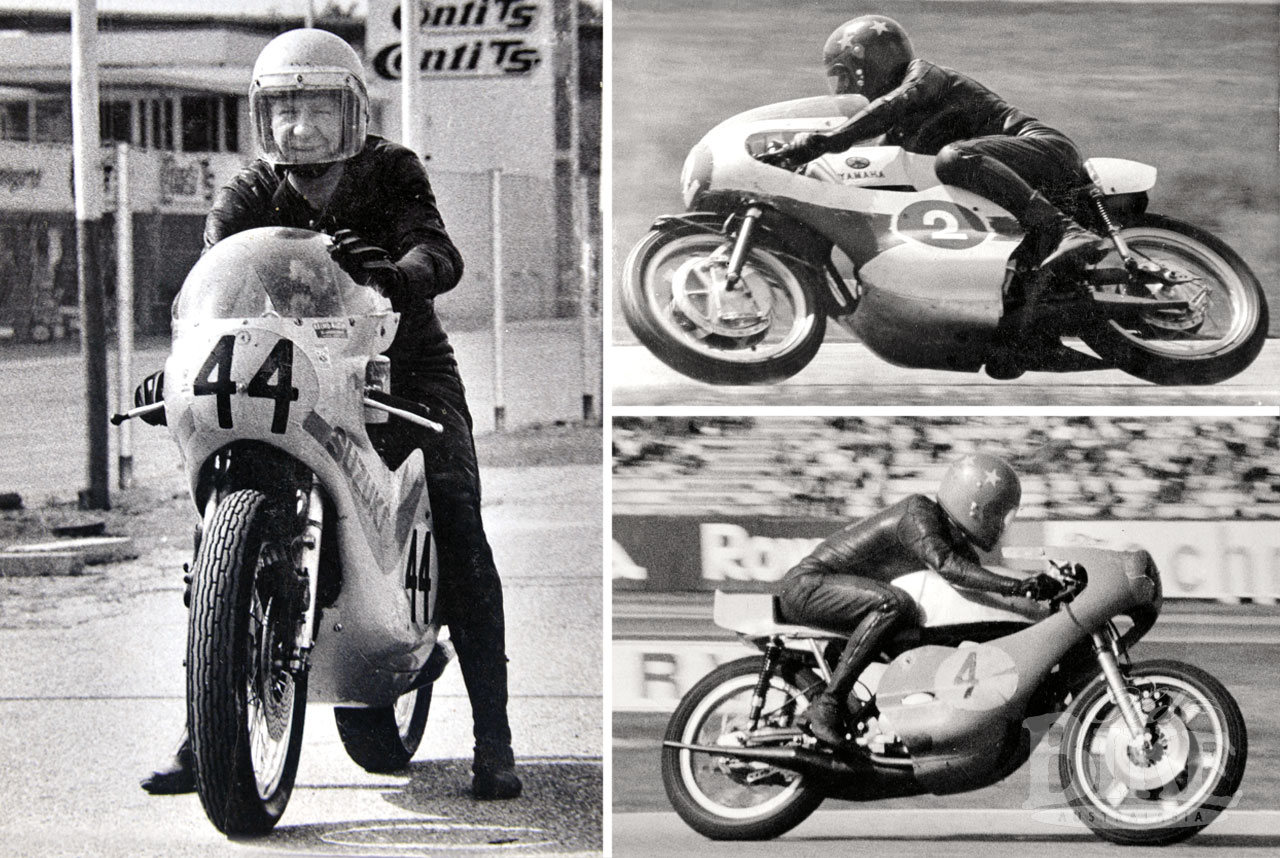
Bottom right: On the TR500 at Hockenheim, 1974.
With his injuries healed and memory returned, Ron stepped back into competition, riding 250 and 350 Aermacchis with some help from the factory. In an effort to keep the Italian singles competitive, he took his ideas on chassis design to the Rickman Brothers in England, who constructed a frame to his specifications for his 350 engine. “We took the Aermacchi with the Rickman frame – un-plated in bare metal – to Thruxton and tested it, and it went very well so we pulled it apart and had the frame nickel plated and I took it back to Germany.” But the two-strokes were coming and Ron could see the writing on the wall. He purchased an air-cooled Suzuki TR500 twin from multiple German Champion Lothar John, and this was soon joined by a 250cc TD2 Yamaha. “Every time I raced the Suzuki at Hockenheim it would burn a hole in a piston and we couldn’t work out why. Lothar had made the heads himself and they were sand cast and were porous and the sand holes would glow, so going through the pine forest in Hockenheim with more oxygen in the air it would burn a hole in the piston. I’d led several times at Hockenheim on this 500, I had it going real quick. “
By now, Ron had set up in business for himself in Vienna, selling Ducatis and duty-free Triumphs imported from England, which he flogged to the US servicemen stationed in the area. He branched out into café racer equipment, importing big quantities of accessories like fuel tanks, exhaust pipes, rear set footrests and seats from Paul Dunstall. The business boomed, and he began supplying agents, having much of the Dunstall-inspired gear made locally, as well as English-made control cables which he bought by the thousands. “I was supplying Austria, Germany, plus Padua and Milan in Italy. I had a Ford Transit van that I put a V6 in with a hot cam and three double Weber carbs, and a Zepher gearbox with overdrive. I could cruise at 200, blow a Porsche off. I was going back and forth to England via the south of France, where all the perfume is made. I’d buy the perfume in big 2 litre bottles, and then I’d buy hundreds of little decanter bottles and stash them away in the transporter and take them to England with me and some of the wholesalers in Birmingham would buy it from me and decant it for the customers’ wives. It was good business. Customs officers in Belgium would get their bottle of whisky, I would stop in a motel and write invoices and send those to my customs agent in Vienna. The customs officers on the border would get a box with a thousand tea bags in it. I had the rackets going!”
Ron eased off racing and opened a business in Manheim in 1973, but later became involved in a German series for 500cc Four Stroke bikes. “You could ride anything as long it was a four stroke under 500cc. I had a friend from BASF Chemical works who entered me on a VF500 Honda twin. It was quick but the others all had streamlining and I didn’t. I rode that up to the end of 1996. In that 500 class I tutored a couple of riders and one of them won the championship”.
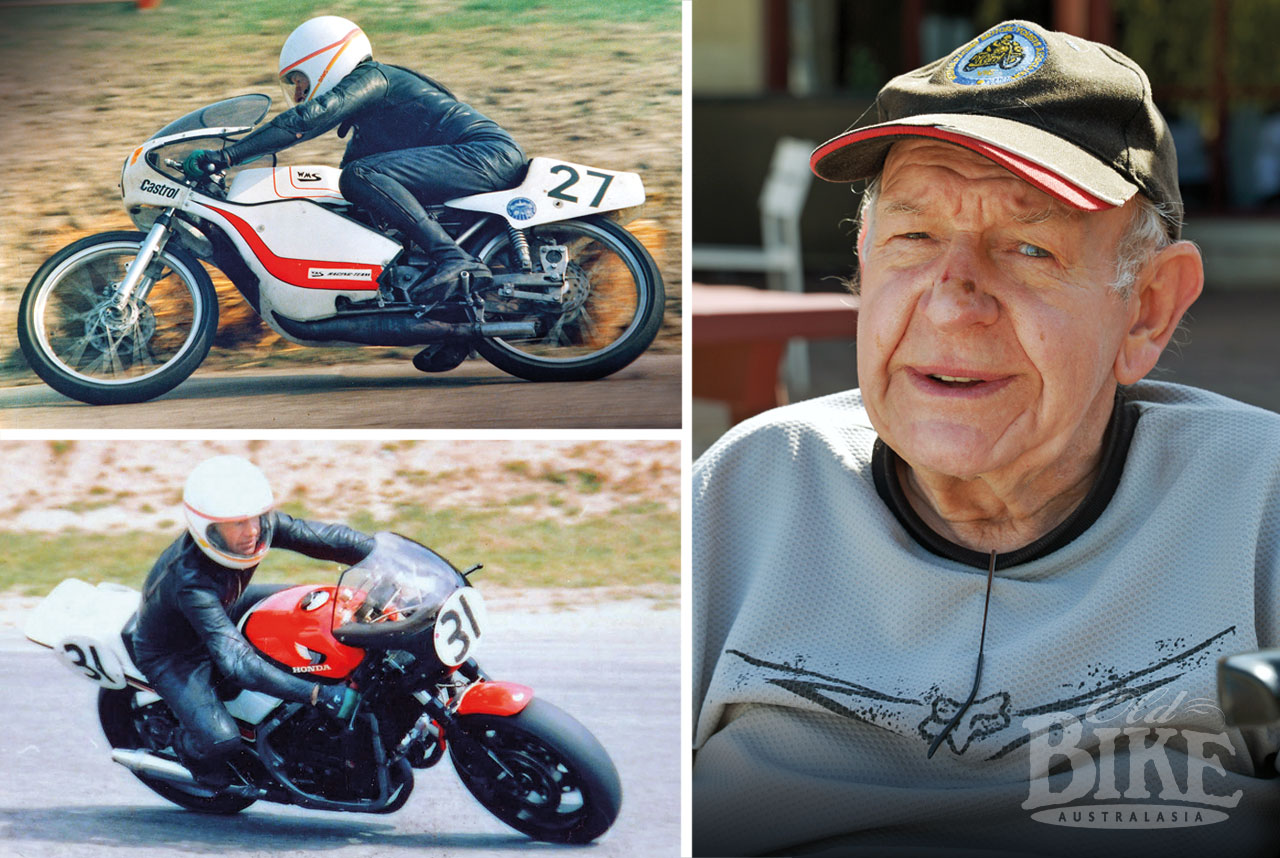
By now Ron was 63, but as enthusiastic as ever when it came to motorcycles and making them go faster. At Manheim he had a small business working on Porsches, superbikes and Honda turbos. He continued his nomadic existence by escorting, and sometimes driving, heavy military vehicles in northern Europe. The work involved moving gigantic equipment across the continent, which had to be done at night to avoid traffic and logistical problems by day. The work was tough and the hours long – he says he still has trouble sleeping normal hours after doing all-nighters for so long. “I did over a million kilometres at night – the authorities wanted you off the roads in the daytime. An English company would ring me and I would meet them at Aachen on the Dutch/German border. I had a telefax in the car and put the papers into the fax to my boss – I operated on the move. I escorted tank transporters and convoys from ‘96 through to 2006.”
Australia seemed a very distant memory by late 2006, when he received the news that his mother had passed away in Melbourne. Temporarily (he thought) closing his business in Manheim, Germany, Ron headed home to sort things out. “When I came home that was only going to be for a few weeks to organise my mother’s affairs because I had to get back to my business. I stayed a bit longer because I’d lent some money to somebody. I had a rally Porsche 924 Turbo 932 in storage and the people were away so I bought this Ducati 905 Paso. I was doing a bit of diesel generator servicing and I’d just take my tools and jump on the Ducati”. While visiting Phillip Island, Ron took the Ducati from Cowes to the bay side town of Rhyll – a narrow road that had once formed part of the motorcycle grand prix road circuit in the ‘twenties. “A wallaby jumped out of the scrub and hit me fair in the hip, which was badly broken. It just knocked me off the bike and the police could find no traces of the wallaby, so I don’t think they believed me – but I had the bruising.”
The injury had severe repercussions, with complications arising which needed extensive and expensive treatment. “The doctors said that the bruising on the leg was likely to cause a blood clot if I flew back to Europe. I got some very bad advice and had incorrect drugs prescribed which have caused me no end of pain and problems. It is my greatest disappointment in life that I can no longer ride motorcycles.”
Due to this strange twist of fate, the accident was to signal the end of his time in Europe. Had it not been for an errant wallaby, Ron may still be racing, or at least riding in Historic events. Or he may have returned to his adopted home of Germany and continued his business interests – he was never short of an idea for a money-making scheme. These days Ron’s mobility is severely restricted but he is occasionally to be seen at events like the Broadford Bonanza, and always enjoys a chat about his racing days in Europe, the bikes he has had a hand in developing, and the characters that he met over half a century travelling the length and breadth of Continental Europe.
